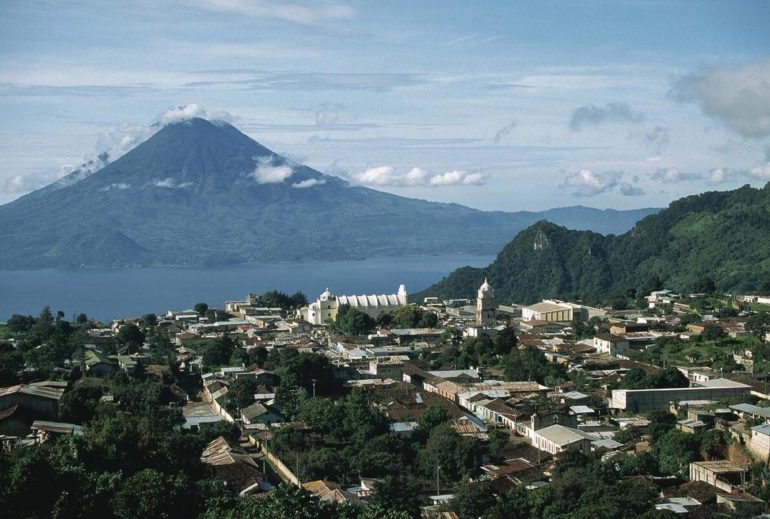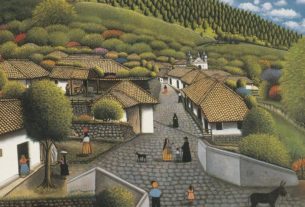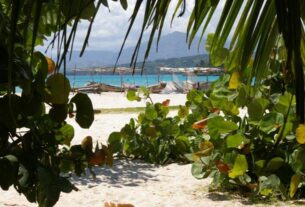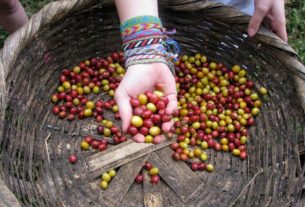Guatemala is a republic in Central America. The country borders Mexico in the north and west, the Pacific in the south, El Salvador and Honduras in the southeast, as well as Belize and the Caribbean in the east. Most of the country is very mountainous and the climate is subtropical.
With around 17 million inhabitants and a relatively developed economy, Guatemala is the big brother in Central America. The capital of Guatemala City is where a wide valley separates the east from the western highlands while providing easy access to the coasts both in the south and the north.
As part of Mesoamerica, Guatemala is one of the places where agricultural-based high cultures first came into existence around 5000 years ago. Spain conquered the area in the 1520s. Around 40 percent of today’s population are descendants of indigenous peoples, mainly Mayan speaking groups. The rest are Spanish-speaking whites and mastics, in Guatemala called Ladinos.
In colonial times, Guatemala was a province of the Viceroy of New Spain, after 1821 it has been an independent republic. From the mid-1950s until around 1990, the country was characterized by strong political conflicts and at times civil war between left-wing guerrilla movements and militarily dominated right-wing governments. A new constitution in 1986 opened for the transition to civilian rule and peace negotiations, which was completed in 1996. The civil war had strong ethnic elements. Most of the approximately 200,000 dead were Indigenous people.
The name Guatemala is náhuatl (Aztec), Quauhtemallan, and means ‘the place with many trees’ or ‘the forest land’. The name of the largest Mayan group, k’iche, has the same meaning in Mayan language.
Geography and environment
The country consists of a number of mountain ranges and highland plateaus, besides a coastal plain along the Pacific coast and a jungle-clad lowland, Petén, in the north. The mountain range facing the Pacific Ocean is volcanic. Eight of the 37 volcanoes are active. The unstable geology also causes frequent earthquakes ; last 1976 when 25,000 people died.
With winds coming in from both seas, most of the country receives ample rainfall. The average varies from 4000 millimeters where the mountains slope down to the Pacific Ocean in the south and Petén in the north, and 400 millimeters in some places inland. The combination of volcanic soil, subtropical location and dramatic elevation differences make Guatemala an exceptionally high biodiversity. Annual average temperature is 15 degrees in the highlands and 28 degrees on the coasts.
Guatemala is located in the hurricane belt and is exposed to the climate fluctuations caused by El Niño. Frequent hurricanes in addition to volcanic eruptions and earthquakes make Guatemala extremely exposed to extreme weather. In recent decades, climate change and increased settlement in vulnerable areas have made the country even more vulnerable.
The province of Petén in the north is a flat limestone plateau. Today, Petén is Guatemala’s thinnest area. A thousand years back in time, the area was densely cultivated and here the Mayan culture reached a peak.
The rivers in the highlands are short and rugged, and the lakes are small. The exception is the 130-square-kilometer Atitlán Lake, which fills a caldera after a large volcano that imploded 84,000 years ago. Surrounded by three volcanoes, the place is considered one of the most beautiful in the earth. North and east from the highlands flow the country’s longest and largest rivers. The most water-rich is the Usumacinta that forms the border with Mexico, and the furthest is Motagua (486 kilometers) with an outlet in the Caribbean. On the Caribbean side is also the country’s largest lake, Lago de Izabal (590 square kilometers).
About twelve percent of the land is cultivated land, about 24 percent is pasture land, and forest covers 34 percent. On the Pacific coast and in Petén, large estates dominate where sugar, cotton and palm oil are grown. In the highlands small farms dominate, where corn and beans as well as fruits and vegetables are the most important crops. Coffee, which has long been Guatemala’s most important export product, is grown substantially on the slopes between high and lowlands where the temperature is favorable.
People and society
The birth rate (24.6 per 1,000) is the highest in America, as is the infant mortality rate (23.5 per 100,000). Around 40 per cent of the population is 15 years or younger. Life expectancy is 74 years for women and 70 years for men. The country is characterized by very large social and economic differences and widespread poverty. It is estimated that ten percent of the population has emigrated since 1980 as a result of war, poverty and natural disasters, the vast majority to the United States.
Guatemala is the least urbanized country in the Western Hemisphere. About half of the inhabitants live in one of approximately 9000 small rural communities. This is especially true of the Mayans in the highlands. With its 2.8 million inhabitants, Guatemala City is the country’s industrial and administrative center.
Spanish is an official language, but there are also a number of indigenous languages of the Mayan family as well as xinca (a language isolate) and garífuna (a Caribbean language). The Academy of Mayan Languages recognizes 21 different Mayan languages ; greatest are k’iche ‘, mam, kaqchikel and q’eqchí. The distance between them is as between the Germanic languages.
About 40 percent of the population is indigenous, most of whom belong to different Mayan groups. K’iche ‘is the largest with about two million people. 40 percent are Ladinos. About 18 percent are white, descendants of Spanish colonists and later immigrants from Europe. To this diversity comes about 15,000 xinca and 60,000 garifuna.
The white minority dominates the economy and public administration. The vast majority of indigenous peoples are poor and participate little in national political life. Since the end of the Civil War, Mayans have increasingly established themselves in regional economics and trade, as well as in local politics, but are increasingly disadvantaged with regard to public services such as education and health. Most Mayan communities maintain their own traditions with locally based political and cultural autonomy.
47 percent of the population consider themselves Catholics, while 42 percent consider themselves Protestants (evangélicos). Among the latter are the vast majority of Pentecostal friends. How many people follow Mayan religion – a type of shamanism – is unclear as many consult Mayan priests besides participating in Christian congregation life.
State and politics
Guatemala is a presidential democratic republic. The legislative power lies in Congress. The judicial power lies in an independent judiciary with the Supreme Court at the forefront. In Mayan-dominated areas, annually elected branch mayors (alcaldes comunales) have local judicial authority. The Constitution and the peace treaties state that Guatemala is a multicultural society. The Constitution also gives the Supreme Electoral Tribunal the rank of independent state power with responsibility for holding elections at all levels every four years.
Administratively, the Republic is divided into 22 provinces (departamentos) which are further divided into 340 municipalities (municipios), of which 180 have a majority of Mayans. In the Mayan areas, all residents will belong to a local community (cantón) that chooses their own governing bodies.
Guatemala’s political parties are weak, short-lived and largely organized around strong and presumably electable personalities. Throughout the 2010 figure, the election campaigns have increasingly been infiltrated by black money. The money comes from corrupt handling of public funds as well as the transport of drugs from South America to the United States.
Guatemala’s armed forces include the army, navy and air force as well as an elite force (kaibil) and a presidential guard. There is general military duty for all men between the ages of 18 and 49. The standing force was reduced by two-thirds after the peace agreement, to around 20,000.
Guatemala is one of the UN’s original member states and is an active participant in the UN’s special organizations as well as regional organizations such as the OAS and the Central American Common Market.
Economy and business
Guatemala has the tenth largest economy in Latin America. The country is considered a middle-income country, but the distribution of income is among the most skewed in the world. The economy is on agriculture, both in the form of production of basic commodities (corn, beans) on small farms in the highlands and in the form of capitalist large goods that produce coffee, bananas, sugar and beef in the lowlands. The industry consists essentially of assembling imported products as well as processing food products for the Central American market.
Agriculture accounts for around 13.5 percent of GDP, while the industry employs 31 percent of the workforce. Industry accounts for about 24 percent and service industries for about 63 percent. The value of the funds that migrants in the United States send home is estimated at ten percent of GDP.
In line with the general liberalization of the post-Civil War economy, the country has also developed an export-oriented production of fresh vegetables, fruits, flowers and spices. Among the new export industries, fishing for shrimp and shellfish also has an important place.
The level of investment remains low due to high crime, low skilled labor and poor infrastructure. While the growth rate reached four percent per year until the financial crisis in 2008-2009, it has since fallen to around three percent. With a population growth of around two per cent, poverty has been rising in Guatemala in the decade after 2010.
The United States is by far the most important trading partner. 40 percent of the country’s exports go there, 11 percent goes to El Salvador. Most of the rest goes to Guatemala’s other partners in the Common Market of Central American Countries and the Dominican Republic (CAFTA-DR).
66.6 per cent of the country’s energy consumption comes from hydropower, the remainder mostly from oil and wood. Guatemala has some oil production, but not enough to cover its own consumption.
Mining and forestry also play an important and controversial role as the activities often take place in Mayan-dominated areas, run by large and sometimes foreign companies and the ecological footprint. The forest in Petén is under severe pressure due to harvesting and new construction.
Knowledge and culture
The six-year primary school is free, but in the countryside many quit after three years. Only 74 percent of the population can read and write. The state also runs secondary and vocational schools, but most of the approximately 20 percent who complete do so in private schools that are most often run by denominations. The country has 15 universities, 14 of which are private. The largest is the University of San Carlos (USAC) of 1676.
While urban and prosperous Guatemala shares European-derived traditions in literature, music, dance, art and so on with the rest of Latin America, rural and Mayan Guatemala live in a world of local markets and annual festivals associated with celebrations of local saints. Between these extremes, the vast majority of people are consumers of the modern entertainment industry. Most of the film and music on TV and radio comes from the United States and Mexico.
Guatemala has a literary tradition from before the Spanish conquest. The Mayans had developed a writing system to record important events and divination art. Pop Wuj was written in k’iche ‘in Latin letters around the year 1550 and consists of a creation story, an astrological manual and the history of the k’iche’ dynasty.
Nobel Laureate Miguel Ángel Asturias is the country’s most famous modern author. Among recent authors, the k’iche ‘poet Humberto Ak’abal (1952–2019) has received a number of international awards for his poetry in k’iche’ and Spanish.
The most widespread mass media is TV, radio and newspapers. With the exception of a collaborative chain of local radios, everyone is privately owned. Mexican media magnate Remigio Ángel González owns all four TV channels. Most of the six radio and newspaper companies are also owned by González as well as one other media group.
The paper newspapers have in recent years faced strong competition from social media and from a number of new online newspapers and portals, including Plaza Pública and Nómada. By far the largest paper newspaper is Prensa Libre (founded in 1951).




